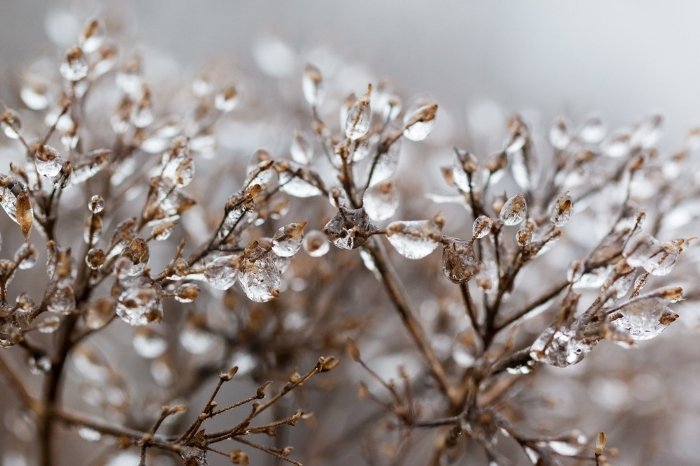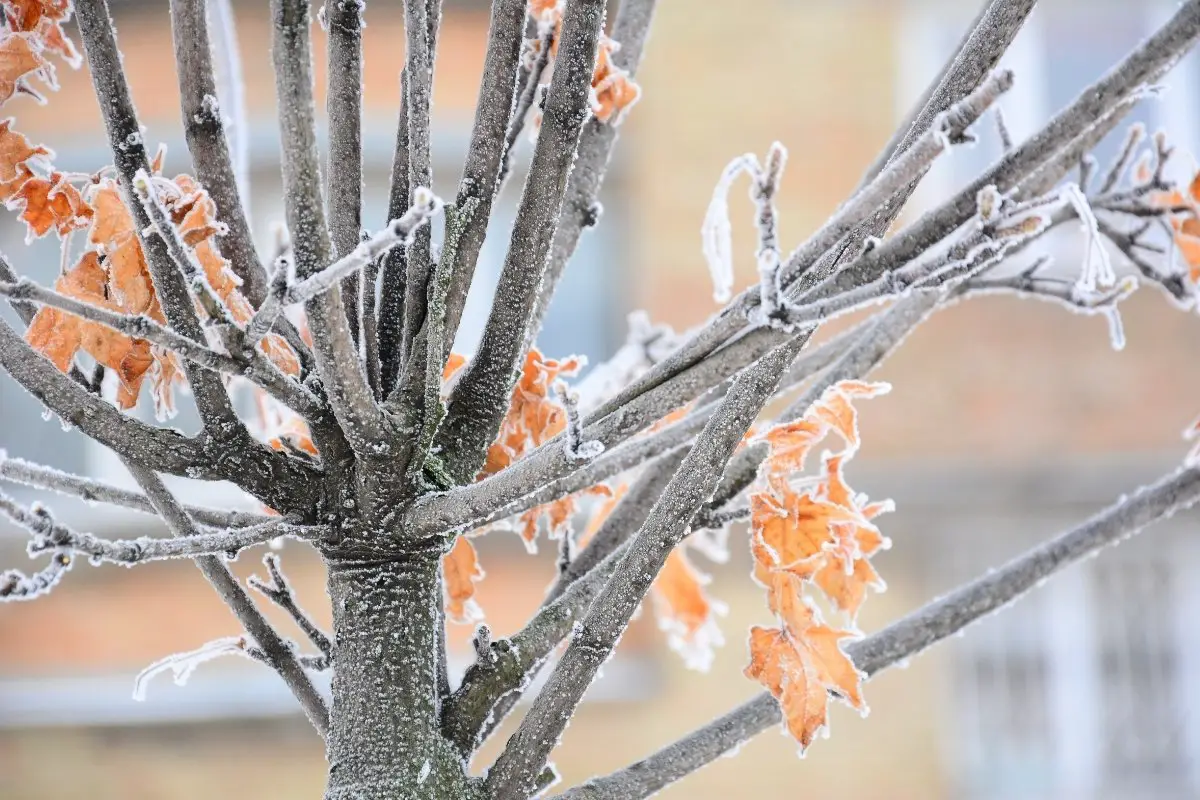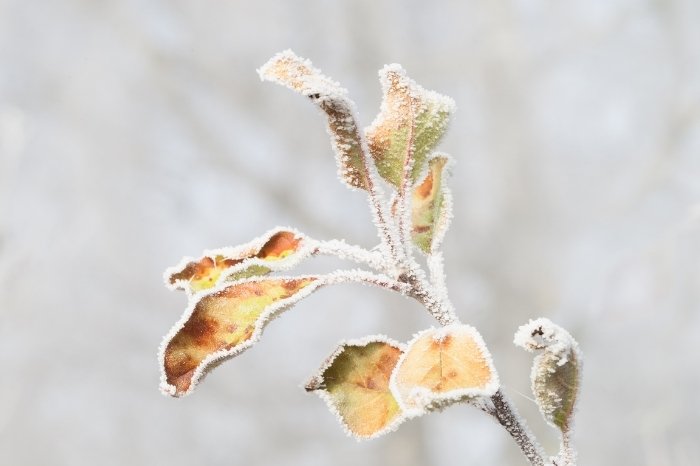Last Updated on March 20, 2023 by Cristina
You’re well aware of freezing weather, but do you know what is considered a hard freeze and how lethal it is to your garden? Most states get first, and last frost dates, and gardeners stick to them. They’re important when planting new plants or transferring the old ones.
The hard freeze happens during winter, and there’s just so much you can do to help your plants survive. Unfortunately, sometimes it can even cause damage to your home!
What Is A Hard Freeze?
There are 3 stages of winter temperatures: frost, freeze, and hard freeze. Mind that these terms are used from an agricultural point of view, not meteorological. All stages affect the 4 P’s – people, pets, plants, and pipes.
As night temperatures start to fall, the moisture in the air cools off and ends up on the ground. During late spring and early fall mornings, you’ll notice dew on plant leaves and other surfaces.
But as winter approaches, the water cools off below the dew point and transforms into frost. This happens when temperatures are around 33°F to 36°F, and there’s enough humidity in the air. You can expect minor damage to plants.

Right after frost, as temperatures continue to fall, we freeze. The freeze happens when we reach 32° and below. These temperatures cause greater damage to your garden.
We experience hard freeze at or below 25°F. This weather is deadly to almost all plants in your garden and requires pipe protection. Depending on the length of the hard freeze, it can even kill hardy perennials.
What is Considered a Light Freeze
The light freeze occurs at 32°F to 29°F and doesn’t cause significant harm to your garden. Delicate vegetation-like crops might suffer some damage. Of course, you need to protect your plants; bring the potted ones indoors, but the hardy plants will manage outside just as well.
Hard Freeze Meaning
While frost is essentially the condensation and freezing of moisture in the air, a hard freeze can happen without a trace. There must be a cold air mass in the area for a hard freeze to happen, usually moved by strong winds.
Along with the temperature below 28°F and the lingering cold air, the ground and all surfaces freeze. When this condition lasts at least 2 hours during the day or night, it’s considered a killing freeze. Depending on when the hard freeze happens, it can kill the plants or disturb the germination process in trees.
If you speak to an experienced gardener, they’ll probably remember a year when hard freeze destroyed their crops.
When Can You Expect Hard Freeze
We can’t predict hard freeze. It’s evident that it happens as soon as temperatures drop below 30°F but following the weather forecast is your best bet. Follow the day temperature; the higher it is, the lower the chances for a hard freeze at night.
A heavy cold wind prevents warm air from settling over the ground and speeds up the freezing process. Pay attention to the sky too. A hard freeze is less likely to happen on a cloudy night. Clouds slow down the cooling as the sun sets and prevent freeze.
Read more about What Is The Ideal Green Bean Plant Spacing?
Which Zones Experience Hard Freeze
USDA Hardiness zones 2 to 7 have a history of low winter temperatures, so they’re most likely to experience a hard freeze. But zones 8 and 9 are not excluded, even though they have higher average winter temperatures.
Winter temperatures never fall below 50°F in California, Florida, Arizona, Texas, Georgia, Louisiana, Alabama, Mississippi, South Carolina, and Nevada.
Your Garden and The Freeze Weather
Hardy crops don’t have trouble surviving mild winter in your garden. Some of them, like peas, should be planted right before the freeze. Check the plant’s resistance before planting it in the fall or early spring. How suitable is your new plant for your Hardiness Zone?
Punada Premium Plant Cover Freeze Protection 8Ft x 24Ft Reusable Row Covers for Winter Frost Freeze
Some plants survive winter just fine and won’t be affected much by an occasional hard freeze. If you can’t be bothered with protection, switch your garden to hardy crops like spinach, broccoli, leeks, kale, cabbage, brussels sprouts, peas, arugula, mustard greens, and onions.
Semi-hardy crops could also withstand a freeze, depending on how long and how often it happens. Try your luck with cauliflower, endive, lettuce, and celery.
Plants That Need Protection
Even light freeze takes its toll on all crops above ground. However, hard freeze causes damage beyond repair. Zucchini, eggplants, tomatoes, okra, peppers, and cucumbers are some of the most tender plants.
Click Here to Learn about:
Have You Considered Protecting Your Garden From Hard Freeze?
Protecting your crops is a must, even if most are hardy. Use mulch to insulate the roots and ground around the plant. This will help retain heat and moisture without freezing.
Pick a suitable cover that will trap the heat from the daily sun and won’t let cold air penetrate. Build a frame to allow the crop to grow in height and keep the cover from collapsing over the tender stems. Then cover with garden fleece or blanket. Finish with plastic foil, secured with rocks.
If your plants are tiny, cut a large plastic bottle in half by the length and cover them.
Cover the plants before you experience the hard freeze and before sunset. Expose them during the day to get the necessary air circulation and sunlight.
Can You Save A Plant After Hard Freeze?
Freeze damage is characterized differently in each plant. Even if they’re perennials, tender crops won’t survive a hard freeze. Hardy crops, as well as roots, can suffer root damage. Scratch the tree; if it’s green under the bark, it means it’s still doing well. Remove any freeze-damaged pieces in spring and fertilize the plant to boost healthy growth.
Does a Hard Freeze Kill Poison Ivy?
Poison ivy is deciduous and will drop its leaves after a hard freeze. This does not mean it is dead – it has just dropped its leaves. If temperatures warm, it will emerge again. This is why this plant lives successfully in huge forest ecosystems that are covered in snow for many months of the year.
What Do You Do With Plants After a Hard Freeze?
This will depend on the plant type. If you are very lucky, and the sun has not yet hit your plants, you may be able to sprinkle water on them and thaw them quickly and both my Mom and I have had a bit of luck rescuing summer seedlings we had put in that were hit by a late cold snap. Generally, any temperature-sensitive plant that is hit by a hard freeze will lose any green parts. For more cold-tolerant plants, wait a few days to a few weeks and see which bits die, and remove these with cutters.
How Do I Keep My Yard Hydrant From Freezing?
You can cover the faucet with a faucet insulation cover such as this. If there is an exposed pipe, you could look at a cover such as this one. If you live in an area that has prolonged sub-zero temperatures the chances are that your building codes require pipe heaters to be installed – if these have not been installed, consider installing something such as this.
What Plants Grow in Freezing Temperatures?
Many plants grow or survive freezing temperatures. Freezing is quite a broad range, but if you are looking for plants to accent parts of your garden, I always advocate the planting of plants that are indigenous to your area as these have adapted to the zone and conditions you are in. In this regard, planting indigenous species helps conserve indigenous plants and the birds and wildlife that need those plants.
Something I have enjoyed seeing as a trend is the evolution of seed suppliers who sell “indigenous” seed blend mixes for meadows. Here is an article I wrote about meadows and why these are a really good alternative to a costly, and largely useless lawn.
How Do You Bring a Plant Back to Life After Freezing?
It is important here to differentiate what type of plant. If these are tropical plants, and they have been frozen, the best thing to do, based on my experience is to move them to a warmer area and water them. The surface leaves and so on will most likely die, but maybe the roots will survive and your plant may come back.
If these are spring seedlings you planted outdoors, and they received a bit of freeze damage on the leaves, I have found that sprinkling them lightly with water before the sun hits the leaves can sometimes bring them back – or most of the plants back. I have had some luck resuscitating plants such as lettuce, squash, and tomato this way. Plants such as kale and broad beans will thrive if they get pretty hard cold snaps at night and you water them back to health in the mornings. I have had my best-tasting kale leaves when there has been a bit of frost and freezing of other plants nearby. The same applies to broad beans.
If these are naturally adapted outdoor plants that have had a bit of frost or freeze damage, let them do their own thing. If they survived in your area before without your help, they can keep doing that. After the cold ends, you can prune the plants to remove dead leaves and stems. I would wait a few weeks to do this – some wild plants manage to recover branches you would think were dead.
How Long Does it Take Plants to Die Below Freezing?
This will depend entirely on the plant. Some plants can survive temperatures that are way below freezing, others die at temperatures above freezing. As an example, a Coconut palm will start to die at temperatures below about 55°F while the purple saxifrage (Saxifraga oppositifolia) can survive conditions in the tundra where temperatures in winter average −18 °F and can drop to as low as −58 °F.
Generally for plants that we may have planted in spring, such as our baby tomatoes, baby peppers, and baby squash you can work on these plants being dead if temperatures hit freezing for longer than an hour. Soft green leafy plants die when they freeze. Consider using cloches to protect your spring transplants. (the cloche featured here is a good design, even if the marketing wombat that took the picture called something that is not a carrot, a carrot.)
What Plants Can Survive Freezing Temperatures?
Echinacea species (Coneflowers) which are actually indigenous to USDA hardiness zones 3-8 are a good choice for flower beds in these regions. This is because the plants are naturally adapted to deal with the temperatures prevalent in the zones. Mulching your beds before winter can also help these plants emerge strongly in spring.
Meadow mixes of seeds for planting in colder areas are available from time to time with products such as this one being an excellent example. This provides a broad range of seeds that you can plant – many of these are perennials and will emerge at an appropriate time and temperature in spring, to be beautiful for you. Some others will form seeds that overwinter and germinate at the right time as well. Nature does generally know how to survive in your climate zone, so often growing plants that are in fact indigenous to your area is the best way of ensuring maximum survival of plants.
There are many other plants, such as your evergreen pine (Pinus species), Fir (Abies species), and spruce (Picea species) trees and the like that can survive very cold temperatures and can provide a bit of green in the colder months.
Bottom Line: What is Considered a Hard Freeze
The hard freeze happens when temperatures fall below 28 and stay in the low twenties for over 2 or 4 hours. The hard freeze, unlike the frost, it’s extremely damaging and can kill off a significant part of the vegetation in your garden.
To avoid empty garden beds in spring, protect your crops and bring in your potted plants. Closely follow the weather forecast to avoid being too late.
Mary is a passionate gardener who loves spending her days getting her hands dirty and nurturing her plants. She‘s an avid reader of gardening magazines and is always looking for new ways to make her garden thrive. When not outside tending to her plants, Mary can be found inside reading up on the latest gardening trends, comparing notes with fellow gardeners, and finding the perfect pottery planter for her next planting project.




